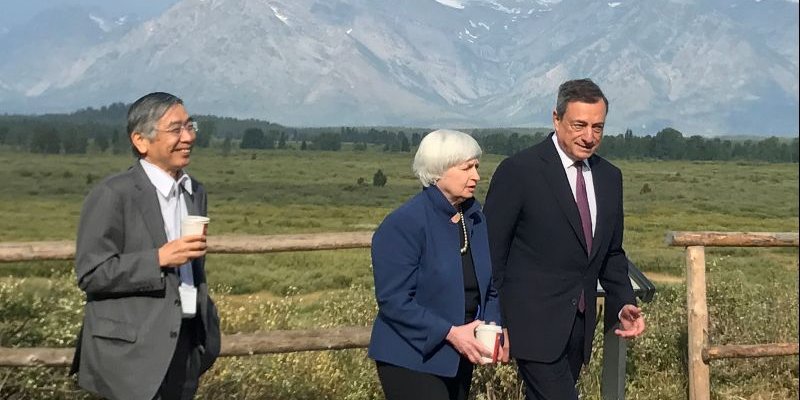 Governor of the Bank of Japan Kuroda, United States Federal Reserve Chair Yellen and President of the European Central Bank Draghi walk after posing for a photo opportunity during the annual central bank research conference in Jackson HoleThomson Reuters
Governor of the Bank of Japan Kuroda, United States Federal Reserve Chair Yellen and President of the European Central Bank Draghi walk after posing for a photo opportunity during the annual central bank research conference in Jackson HoleThomson Reuters
- The next global financial crisis could force central banks to cut to unprecedented negative rates.
- UBS Investment Bank argues that economies including the UK, Denmark, and New Zealand could see rates as low as -5%.
- Bank says that rate cuts in next global downturn would be much more than “a few manageable bips.”
- “If the recession were to come today, we’d be in trouble,” Arend Kapteyn, global head of economic research said at a briefing.
LONDON — Global central banks would need to cut interest rates to unprecedented sub-zero rates to have any positive impact on growth and effectively shield their respective economies, according to research from the investment banking arm of Swiss giant UBS.
Writing in its Global Economic Outlook for 2018-2019, a 223-page epic report, the bank argues that global rates remain so low 10 years on from the crisis, that the next major global correction could leave central banks scrambling for ways to stimulate the economy.
Pointing to a chart from the outlook, the banks economists note that global central banks, if they needed to respond as robustly as they did during the 2007-08 crisis, would be forced to drop interest rates as low as -5%. That is quite simply something that has never happened before.
“One of the concerns right now is that we’re in a very mature business cycle recovery, with a lot of people asking ‘When is the next recession coming?’,” Arend Kapteyn, UBS’ global head of economic research said at a briefing on Monday.
“If the recession were to come today, we’d be in trouble, because there’s basically no policy space,” he continued.
And here is that chart (green triangles show where rates would need to go if the next crisis happens imminently):
 UBS Investment Bank
UBS Investment Bank
“There’s no space on the policy rates side, there is no space in terms of compressing long end yields, there is no space in terms being able to run public debt levels a lot above where we are now. That’s a matter of concern.
“Although there’s been an incredibly slow recovery, it’s a taken a long time to get where we are, we have not yet recouped the policy space.”
Here’s what UBS has to say in the more complex language of the report (emphasis ours):
“It is worth asking whether from a policymaking perspective, governments and central banks would be able to respond, given how little normalization appears to have taken place since the last crisis.”
“The third feature of the chart, the green triangles, shows where policy rates would need to go if the response to the next recession were similar to that in the last recession. Yes, you can argue that the last recession was particularly severe, and indeed we showed in the previous section that both output losses and the monetary policy responses were larger than in previous crisis episodes. But for illustrative purposes let’s show where rates would need to go if policymakers wanted to react with the same fortitude to the next recession.”
“All of DM and about half of EM would have to go seriously negative — not a few manageable bips but between -4% and -5%. Even a world slump half as deep as the GFC would push many countries hard against an effective lower bound.”
During the last crisis, global central banks cut interest rates aggressively to protect consumers and lenders from the worst impacts of that crisis. Then, however, they were cutting from a much higher base.
The US Federal Reserve’s base interest rate in late 2007, just as the crisis was beginning to crystallise, was 5.25%, compared to just 1.25% now. Similarly, the Bank of England cut from 5.75% to just 0.5%, where the rate currently sits.
In the 10 years or so since the crisis, rates have remained subdued as central banks try to eke out as much growth as possible from their recovering economies. Rates are starting to move a little higher — the Fed, for example, has increased its base rate four times in the last couple of years — but are still well below where the were pre-crisis.
Therefore, if central banks wanted to cut rates with that same aggression, they would be forced to not only go negative — as is already the case in the eurozone, Denmark, Sweden, and Switzerland — but to drop to even greater record lows.
“As long as the volatile components of GDP (investment) are lacklustre and the labour market is showing no sign of wage pressure or overheating, there is little need for the central bank to step on the brakes — one traditional way to see growth stall,” UBS’ team said.













